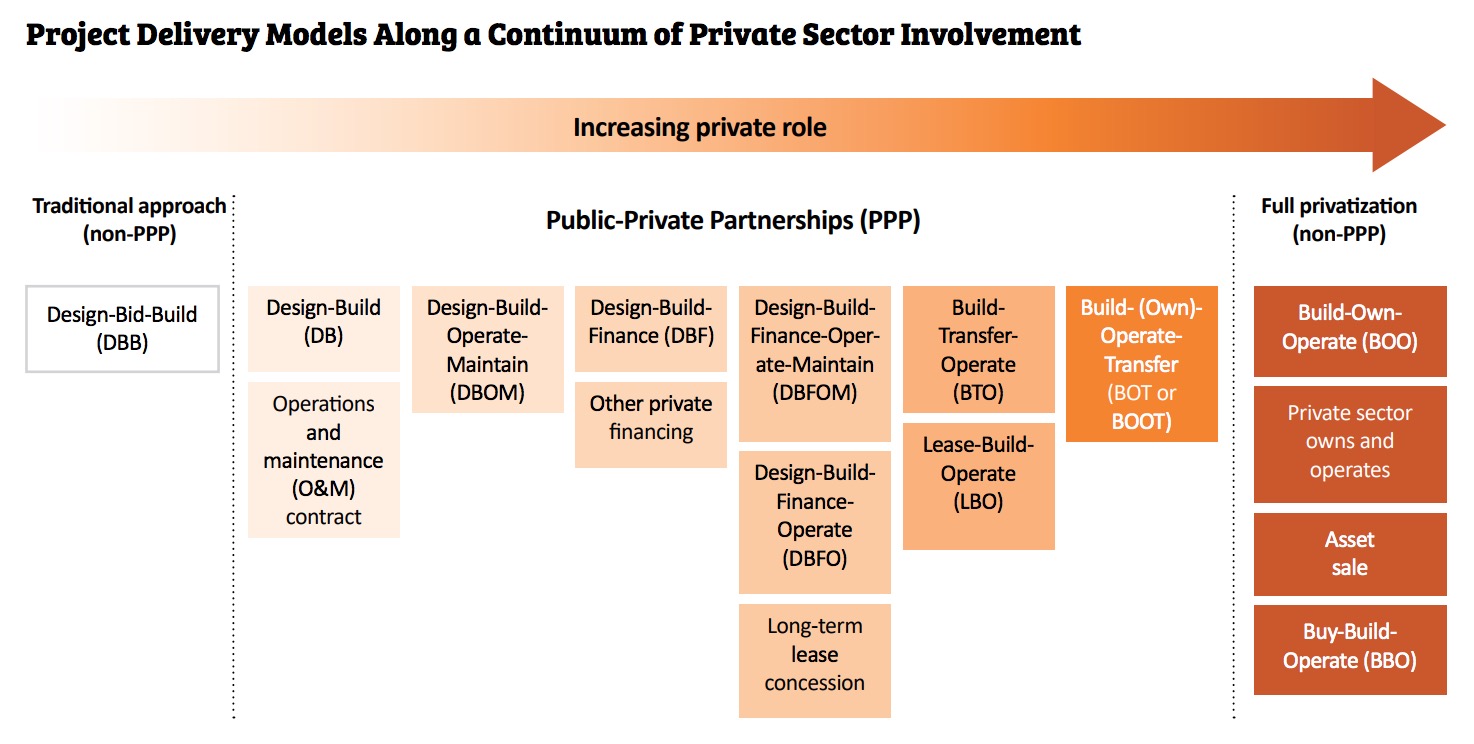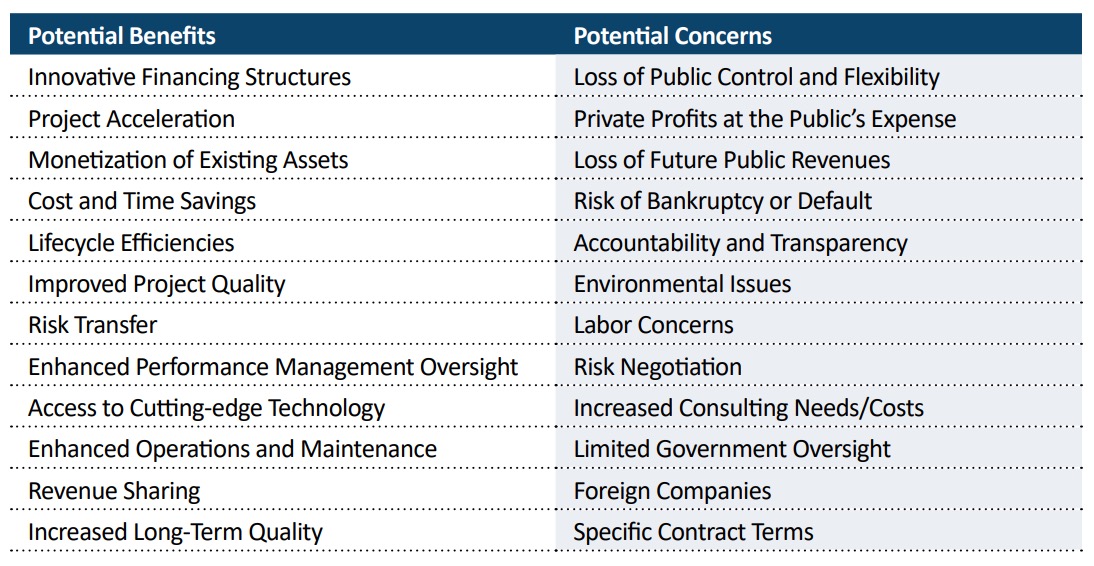NATIONAL CONFERENCE OF STATE LEGISLATURES (NCSL)
The 2016 NCSL Foundation Partnership on Multi-Sector Public-Private Partnerships
By Kevin Pula, Senior Policy Specialist, NCSL
Since 2010, the public debate over P3s has expanded from the transportation sector into other types of government-delivered infrastructure. An increasing number of states—led by Virginia, Texas, Florida, Indiana and Pennsylvania—began entering into P3 agreements to help alleviate shortfalls in critical resources for building, maintaining and operating public infrastructure projects.
As a response to growing state legislative interest and market activity, NCSL once again sought to discuss P3 best practices and challenges.
The 2016 NCSL Foundation Partnership on Multi-Sector Public-Private Partnerships established a strategic working group comprised of state legislators, legislative staff and private-sector stakeholders. Building from the groundwork of its 2010 predecessor, this initiative was designed to explore the use of P3s for non-transportation specific infrastructure. The initiative’s goal is to provide lawmakers and public stakeholders with the expertise and assistance needed to create and implement sound P3 policy.
P3 Policy Primer
The following content in this section is adapted from the NCSL P3 Toolkit for Legislators. A full discussion of P3 models, key characteristics, and benefits and concerns is available in the Toolkit.
P3s Defined
Because P3s cover a broad range of innovative contracting, project delivery and financing arrangements, a singular definition is difficult to establish. P3s take various forms based on the type of infrastructure involved and level of risk sharing sought by the public sector. Key characteristics of P3s, delineating them from typical arrangements between the public and private sectors, include the transfer of risk from the public sector to the private sector, the marrying of multiple steps of the procurement lifecycle and the shifting of some public sector responsibilities to the private sector.
One definition which is widely accepted and can be useful beyond the area of transportation comes from the U.S. Department of Transportation:
“A public-private partnership is a contractual agreement formed between public and private sector partners, which allows more private sector participation than is traditional. The agreements usually involve a government agency contracting with a private company to renovate, construct, operate, maintain, and/or manage a facility or system. While the public sector usually retains ownership in the facility or system, the private party will be given additional decision rights in determining how the project or task will be completed.” —The U.S. Department of Transportation 
P3 Models
P3s can take the form of a range of models depending on the ultimate goals and resources of the public sector. The spectrum of P3 models (above) ranges from a design-build (DB) model to lease-build-operate (LBO) or build-operate-transfer (BOT) models. Primarily, large-scale P3s in the United States consist of design-build-operate-maintain (DBOM) or design-build-finance-operate-maintain (DBFOM) models.
Marrying multiple phases of procurement within a P3 agreement allows for increased risk transfer and creates innovation within the design, construction and operations phases. For example, in a DBOM or DBFOM agreement where the concessionaire is responsible for the long-term operations and maintenance of an infrastructure asset, they will likely make certain design and construction decisions that would otherwise be unlikely under a design-bid-build model due to costs (i.e. using more costly materials that will require less maintenance or provide ease of operation in the decades to come).
This dynamic is often described as low bid versus best value by proponents of P3s. By accepting higher costs for some aspects of a project, the public sector may realize increased overall value throughout the life of the project.
Another key aspect of P3s is the underlying revenue stream being leveraged by this financing tool. P3s can be delineated into two main buckets per their revenue streams, availability payments or revenue risk (also known as volume-based) projects. Availability payment P3s are structured so that the private concessionaire receives contractually scheduled payments from existing or future public sector budgets. Revenue risk P3s involve allowing the private concessionaire to access, to some degree, a project’s revenue stream (such as tolls or user fees) as payment, either in full or in part, for their fulfillment of their responsibilities under the agreement. Revenue risk deals may also include scheduled or milestone payments from non-revenue based funds to supplement the project’s user fees.
Revenue risk P3s are closely associated with toll-concession P3s, however, non-transportation based P3s can still include revenue risk. The Denver Union Station P3, the Long Beach Civic Center P3 and the FBI Headquarters P3 all include examples of project revenues streams (special taxing districts, parking facilities, retail development and land-swap agreements) for non-transportation based projects. Depending on the goals of the public sector, these revenues may be used as leverage to transfer risk to the private sector or the user risk may be retained by the public owner.
Potential Benefits, Concerns and Controversies
The following content in this section is adapted from NCSL’s Building Up: How States Utilize P3s for Social and Vertical Infrastructure. A full discussion of P3 concerns and controversies can be found in that report and the P3 Toolkit.
As P3s have become a focus of the national conversation on infrastructure spending, it is important to consider what they can and cannot provide. Even the most well-intended projects can go astray without proper oversight and consideration.
Some common potential benefits and concerns associated with P3s are listed in the table below.
These benefits and concerns need to be addressed at the outset of any P3 agreement. The partnership’s concessionaire agreement is considered by many P3 experts to be the most appropriate place to alleviate any potential issues associated with specific projects. Ideological and project-neutral concerns may be addressed in the legislature when debating the creation of P3 enabling laws.
Sound public policy through state law is the primary and most authoritative tool state legislatures have to alleviate any issue. Many state legislatures have enacted statutory provisions to address potential concerns about P3s and enhance the benefits such models can provide. Depending on the goals of the legislature and all parties involved, these benefits and concerns are handled differently, which means enabling laws will vary from state to state.
Critical to the discussion on P3s is the clarification that P3s do not act as a funding source; rather, they can provide additional financing opportunities and create efficiencies leading to cost savings. Nor are P3s a cure-all for infrastructure funding needs.
A primary concern in recent years is the limited practicality of P3s for small and medium cost projects. P3s are closely associated with large transportation projects and it is difficult to discern ways in which P3s can aid rural regions looking for infrastructure improvements. Smaller jurisdictions often lack the staff for less traditional procurements approaches and may be reluctant to utilize highly complex or costly alternatives.
The potential lack of scalability can act as a barrier for small communities to pursue P3s. The substantial financial and legal expertise required drives up costs and can quickly outweigh potential benefits able to be realized on a small project. Thus, bundling is one strategy pursued by some states, with limited success, to achieve a project size large enough to offset increased upfront costs and complexities. By merging multiple small but similar projects, the state could increase the total size of the project to justify the increased costs associated with risk transfer and P3s. Regional councils of governments, state procurement agencies and the U.S. General Services Commission could potentially all play a role in creating bundled opportunities. Expanding procurement opportunities through cooperative purchasing programs or adding “rider clauses” which all governmental entities to participate in a P3 contract will enable state and local agencies in the same region to leverage existing contracts for similar projects.
Pennsylvania is currently involved in two bundled P3 projects, the Rapid Bridge Replacement P3 and the CNG Refueling Stations P3, combining more than 530 small bridges and 29 refueling stations, respectively. It is still unclear to what extent these projects will be successful and the magnitude of realized public benefit.
A related strategy utilized in some jurisdictions includes expanding procurement opportunities through cooperative purchasing programs or adding so called “rider clauses” in P3 contracts which enable other state or local agencies to leverage existing contracts for similar projects.
Another model for leveraging the potential benefits of P3s for smaller and midscale projects is spearheaded by the National Development Council (NDC). The NDC’s American Model ™ seeks to abide by two principles: “Public debt structures are less costly than private debt structures and private development is more efficient than the public development process.” By using its group exemption to create a special purpose entity to design, build, operate and maintain a project, NDC has utilized public sector debt structures—tax-exempt 63-20 bonds and 501(c)(3) bonds—to realize 42 P3 projects amounting to more than $2.5 billion in total development. Over the past three decades, NDC has partnered with both governments and nonprofit institutions to construct municipal office buildings, county justice centers, libraries and other types of social infrastructure by “blending” private sector efficiencies of a P3 with the low cost of public financing
Download full version (PDF): P3 Infrastructure Delivery-Principles for State Legislatures
About the National Conference of State Legislatures
www.ncsl.org
Since 1975, NCSL has been the champion of state legislatures. We’ve helped states remain strong and independent by giving them the tools, information and resources to craft the best solutions to difficult problems. We’ve fought against unwarranted actions in Congress and saved states more than $1 billion. We’ve conducted workshops to sharpen the skills of lawmakers and legislative staff in every state. And we do it every day.
Tags: Kevin Pula, National Conference of State Legislatures, NCSL, P3s, PPPs, Public-Private Partnerships







 RSS Feed
RSS Feed